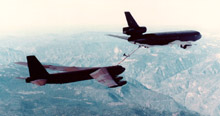|
Under the exclusive control of the Pentagon and without the ill-effects of political meddling, Operation Linebacker II commenced during the night of December 18, 1972. Airbases at Hoa Lac, Kep, and Phuc Yen were attacked, as well as rail and warehouse facilities at Yen Vien and Kinh No. From the beginning of the operation, losses were heavy. On the first night, two B-52s were shot down by missiles. The second night, the force lost none of the bombers, though several were damaged. The North Vietnamese were smart operators -- they watched, studied and learned about US bombing techniques. Conversely, Air Force planners were emboldened by the success of the second night and made almost no changes in the attack plan for the third night of operations.
The situation worsened when the bomber's protected corridor of chaff (which reflected radar, hiding the bomber's location) was blown to the side by abnormally high winds. The bombers were particularly vulnerable after their target run, when they would bank into a turn to head home. In this position, their downward pointing air defenses would be pointing to the sides (with the plane in a banked turn), leaving the B-52s open to attack. In response, the US changed tactics. After the bomb run, the US planes would fly straight out to sea before making their turn toward home. In addition, the SAM sites and SAM storage areas were mercilessly bombed. Thousands of missiles were destroyed, many still on storage racks. With the end of the SAM threat, losses fell off, such that only an additional seven aircraft were lost before the bombing was halted nine days later. The entire campaign would last just eleven days -- it was punishment enough to convince the North Vietnamese to return to the Paris table and negotiate seriously. In all, Operation Linebacker II saw 729 B-52 missions flown, dropping 15,287 tons of bombs on 34 targets. Damage across North Vietnam was extensive. In all, 1,600 military structures were hit, 3 million gallons of petroleum had gone up in smoke, and 80 percent of the country's electrical power production had been destroyed. The Vietnamese had learned the hard way that the B-52, given enough time, really could "bomb them back into the stone age." In air-to-air combat, the B-52 also proved itself well. A total of five MiGs were claimed, though ultimately just two were confirmed. Not a single bomber was lost to a MiG. The negotiating round that followed Linebacker II was over by the end of January. An agreement terminating America's involvement in the South was in place and less than two months later the North released what it claimed was all American POWs. Another year of Arc Light missions would follow, finally ending on August 15, 1973. By October, all B-52s were withdrawn from the region. |
 It would prove to be a disaster. Six B-52s were shot down. Russian-made SAMs filled the night skies around Hanoi and Haiphong. Furthermore, MiG-21s aggressively hunted the bombers, not only engaging them but more importantly radioing altitude, heading and speed information to the missile controllers below.
It would prove to be a disaster. Six B-52s were shot down. Russian-made SAMs filled the night skies around Hanoi and Haiphong. Furthermore, MiG-21s aggressively hunted the bombers, not only engaging them but more importantly radioing altitude, heading and speed information to the missile controllers below.